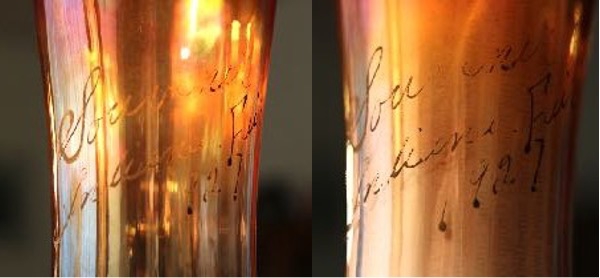The Lakecefa Souvenir Vase
By Dr. Larry Keig
The Lakecefa vase is big and beefy with a plain exterior and a 10 concave-ribbed interior. It stands 10 inches tall, its gently 10-scalloped top measures four inches in diameter, its plain base also spans four inches.

This vase is a Diamond product, probably introduced in the mid-1920s. It is apparently the first-reported item in this pattern.
Its surface color is technically marigold. However, the matter of color is more nuanced than that. It is marigold on clear only on the top half and is a non-iridescent clear below that. The color, then, might best be described as marigold and clear rather than simply marigold on clear.
According to the text of an advertisement for the Beauty Bud Vase in a 1916 Butler Bros. catalogue (and subsequent editions of the same wholesaler’s promotional materials), these vases were packed to points of distribution “1 ½ dozen clear, 1 ½ dozen with amber [that is, marigold] iridescent top.*.
This “amber and clear” iridescent treatment also applies to the Lakecefa vase as it is a vibrant multicolor marigold on the top half of the vase and clear below that all the way to the bottom. Distasteful as this color effect is to most collectors of today, it may have had more appeal to buyers of a century ago.
An “Indiana Fair” Lakecefa Souvenir
While it is probable that unlettered Lakecefa vases are available, this particular vase is one more of Diamond’s carnival and stretch glass Indiana Fair commemoratives. It is hand-lettered “Souvenir/Indiana Fair/1927,” the inscription placed on the marigold portion of the vase. This is, it appears, the final year in which the firm produced iridescent keepsakes for its hometown Indiana, Pennsylvania, county fair.

The vase was listed on eBay in the spring of 2020 by a seller from Penn Run, Pennsylvania, just a few miles from Indiana where the plant operated. He noted that he found this vase and a cobalt Apple Blossom Twigs plate with “Indiana Fair 1921” lettering in that area. This anecdotal account provides additional confirmation that Indiana Fair souvenirs were produced for the local county fair where the glass was made and not for the state fair in the state of Indiana. One has to wonder what Dugan and Diamond pieces still change hands in the vicinity of the plant.
In addition to the Lakecefa vase, at least 10 different iridescent Indiana Fair items are known: Adam’s Rib mug, Apple Blossom Twigs plate, Band hat and Band baskets with looped factory attached glass handles in two pattern versions and two colors, Coin Spot compote, Windflower plate, an unnamed and unpatterned mug, and two additional items illustrated in a classic book on glass made at the Indiana, Pennsylvania, factory.** There may be others. A summary of those that have been confirmed is provided in the accompanying table.
If any of you own or have seen a Lakecefa vase, with or without souvenir lettering, I’d really appreciate hearing from you. I’d also like to hear from you if you know of Indiana Fair hand-inscribed souvenirs other than those I have identified.
Notes
*Kathi Johnson called my attention to this color treatment. She found it described in an ad on the Carnival Glass 101 Beauty Bud vase page with a related note from Diane Fry, curator for many years of the101 website.
**Heacock, Measell,& Wiggins, Dugan/Diamond ,1993.
Photos courtesy of Diane Highnam.
Table. Indiana Fair Carnival and Stretch Glass Souvenirs
| Pattern | Shape | Date | Color | Glass Type* |
| Adam’s Rib | Mug |
1926 1927 |
Celeste Blue | Stretch |
| Apple Blossom Twigs | 9” Plate | 1921 | Cobalt Blue | Carnival |
| Band, Plain Band |
Hat Basket |
1925 1922 |
Amethyst Marigold |
Carnival |
| Band, Lattice Band | Basket | 1924 | Marigold | Carnival |
| Coin Spot | Compote | 1922 | White | Stretch |
| Lakecefa | Vase | 1927 | Marigold | Carnival |
| Windflower | 9” Plate | 1921 | Cobalt Blue | Carnival |
| Unpatterned | Mug | 1926 | Celeste Blue | Stretch |
| Unnamed, Ribbed Int. | Mug | 1927 | Celeste Blue | Stretch |
| Unnamed and Unpatterned | 6-7” Plate | N/D | Blue Lustre | 20s Lustre |
*Designation based on appearance
This article first appeared in the ICGA Pump in the June 2022 issue and is reprinted with permission.
